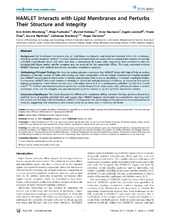| dc.contributor.author | Mossberg, Ann-Kristin | en_US |
| dc.contributor.author | Puchades, Maja | en_US |
| dc.contributor.author | Halskau, Øyvind | en_US |
| dc.contributor.author | Baumann, Anne | en_US |
| dc.contributor.author | Lanekoff, Ingela | en_US |
| dc.contributor.author | Chao, Yinxia | en_US |
| dc.contributor.author | Martinez, Aurora | en_US |
| dc.contributor.author | Svanborg, Catharina | en_US |
| dc.contributor.author | Karlsson, Roger | en_US |
| dc.date.accessioned | 2010-12-13T09:50:15Z | |
| dc.date.available | 2010-12-13T09:50:15Z | |
| dc.date.issued | 2010-01-23 | eng |
| dc.Published | PLoS ONE 5(2): e9384 | en |
| dc.identifier.issn | 1932-6203 | |
| dc.identifier.uri | https://hdl.handle.net/1956/4337 | |
| dc.description.abstract | Background Cell membrane interactions rely on lipid bilayer constituents and molecules inserted within the membrane, including specific receptors. HAMLET (human α-lactalbumin made lethal to tumor cells) is a tumoricidal complex of partially unfolded α-lactalbumin (HLA) and oleic acid that is internalized by tumor cells, suggesting that interactions with the phospholipid bilayer and/or specific receptors may be essential for the tumoricidal effect. This study examined whether HAMLET interacts with artificial membranes and alters membrane structure. Methodology/Principal Findings We show by surface plasmon resonance that HAMLET binds with high affinity to surface adherent, unilamellar vesicles of lipids with varying acyl chain composition and net charge. Fluorescence imaging revealed that HAMLET accumulates in membranes of vesicles and perturbs their structure, resulting in increased membrane fluidity. Furthermore, HAMLET disrupted membrane integrity at neutral pH and physiological conditions, as shown by fluorophore leakage experiments. These effects did not occur with either native HLA or a constitutively unfolded Cys-Ala HLA mutant (rHLAall-Ala). HAMLET also bound to plasma membrane vesicles formed from intact tumor cells, with accumulation in certain membrane areas, but the complex was not internalized by these vesicles or by the synthetic membrane vesicles. Conclusions/Significance The results illustrate the difference in membrane affinity between the fatty acid bound and fatty acid free forms of partially unfolded HLA and suggest that HAMLET engages membranes by a mechanism requiring both the protein and the fatty acid. Furthermore, HAMLET binding alters the morphology of the membrane and compromises its integrity, suggesting that membrane perturbation could be an initial step in inducing cell death. | en_US |
| dc.language.iso | eng | eng |
| dc.publisher | Public Library of Science | eng |
| dc.rights | Attribution CC BY | eng |
| dc.rights.uri | http://creativecommons.org/licenses/by/3.0/ | eng |
| dc.title | HAMLET interacts with lipid membranes and perturbs their structure and integrity | en_US |
| dc.type | Peer reviewed | |
| dc.type | Journal article | |
| dc.description.version | publishedVersion | en_US |
| dc.rights.holder | Copyright 2010 Mossberg et al. | |
| dc.rights.holder | Mossberg et al. | |
| dc.identifier.doi | https://doi.org/10.1371/journal.pone.0009384 | |
| dc.identifier.cristin | 340800 | |
| dc.subject.nsi | VDP::Medisinske Fag: 700::Basale medisinske, odontologiske og veterinærmedisinske fag: 710::Medisinsk biokjemi: 726 | nob |

